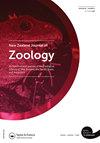奥克兰凯帕提基地区鸟类数量的年度变化
IF 1.1
4区 生物学
Q3 ZOOLOGY
引用次数: 0
摘要
摘要鸟类是生态系统健康的良好指标。监测种群可以为保护行动提供有用的信息。奥克兰Kaipatiki约有450个 公顷的土著森林、灌木丛和湿地生态系统。害虫控制区对支持鸟类生物多样性很重要,然而,随着时间的推移,凯帕提基还没有对其进行广泛的测量。一种测量鸟类生物多样性和数量随时间变化的既定方法是使用固定点计数。使用这种方法,在连续三个繁殖季节(2016-2018)对19个保护区的鸟类进行了计数。我们还对凯帕提基的哺乳动物捕食者和鸟类数量进行了相关分析,以检验这些关系。混合建模统计分析表明,2018年所有检测物种的鸟类个体数量明显高于2016年和2017年。Túī、银眼莺、灰莺和扇尾莺是观察到的最常见的本土物种。此外,大鼠相对丰度与鸟类丰度呈显著负相关。凯帕提基正在进行的鸟类计数将有助于提供可靠的长期数据,从而对种群趋势和鸟类物种动态进行可靠分析。这些数据应与每个保护区的哺乳动物捕食者控制数据一起进行相关分析。这将使我们能够根据本地鸟类数量的变化来衡量捕食者控制的有效性。本文章由计算机程序翻译,如有差异,请以英文原文为准。
Annual variation in bird numbers across Kaipatiki, Auckland
ABSTRACT Birds are good indicators of ecosystem health. Monitoring populations can provide useful information to inform conservation action. Kaipatiki, Auckland, contains approximately 450 ha of indigenous forest, scrub and wetland ecosystems. Pest-controlled reserves are important for supporting avian biodiversity, however, this has not been measured extensively over time across Kaipatiki. An established method to measure changes in avian biodiversity and numbers over time is using stationary point-counts. Using this method, bird counts were conducted in 19 reserves during three consecutive breeding season periods (2016–2018). We also conducted correlative analyses on mammalian predator and bird abundance within Kaipatiki to examine these relationships. Mixed modelling statistical analyses suggested significantly higher numbers of individual birds of all detected species in 2018 than both 2016 and 2017. Tūī, silvereye, grey warbler and fantail were the most common native species observed. Further, rat relative abundance had a significant negative relationship with bird abundance. Ongoing bird counts across Kaipatiki will help provide robust long-term data allowing reliable analyses of population trends and avian species dynamics. These data should be subjected to correlative analyses alongside mammalian predator control data in each reserve. This will enable us to gauge predator control effectiveness in terms of native bird number changes.
求助全文
通过发布文献求助,成功后即可免费获取论文全文。
去求助
来源期刊
CiteScore
2.80
自引率
0.00%
发文量
20
审稿时长
>12 weeks
期刊介绍:
Aims: The diversity of the fauna of the southern continents and oceans is of worldwide interest to researchers in universities, museums, and other centres. The New Zealand Journal of Zoology plays an important role in disseminating information on field-based, experimental, and theoretical research on the zoology of the region.

 求助内容:
求助内容: 应助结果提醒方式:
应助结果提醒方式:


